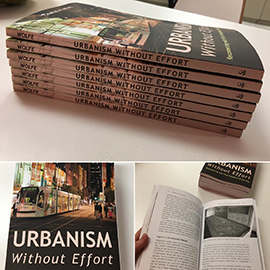Urbanism Without Effort - Book
Researcher:
How do you create inviting and authentic urban environments where people feel at home? Countless community engagement workshops, studies by consulting firms, and downtown revitalization campaigns have attempted to answer this age-old question.
In the new, revised, paperback edition of Urbanism Without Effort, Chuck Wolfe argues that “unplanned” places can often teach us more about great placemaking than planned ones.
A whirlwind global tour, Urbanism Without Effort offers readers inspiration, historical context, and a better understanding of how an inviting urban environment is created. The original 2013 e-book was the foundation for the author’s later, and longer work, Seeing the Better City (2017).

From impromptu movie nights in a Seattle alley to the adapted reuse of Diocletian’s Palace in Split, Croatia, Wolfe searches for the “first principles” of what makes humans feel happy and safe amid the hustle and bustle of urban life. He highlights the common elements of cities around the world that spontaneously bring people together: being inherently walkable, factors that contribute to safety at night, the importance of intersections and corners, and more.
In this age of skyrocketing metropolitan growth, he argues, looking to the past might be our best approach to creating the urban future we dream about. Wolfe believes that these common elements are most interesting when they occur organically—seemingly without effort. He contends it is critical to first isolate these spontaneous and latent examples of successful urban land use, before applying any prescriptive government policies or initiatives.
Wolfe provides something rare in contemporary urbanist writing—rich illustrations and examples from real life—both historical and current. His writing about the past and the future of urban form offers readers inspiration, historical context, and a better understanding of how a sustainable, inviting urban environment is created.


